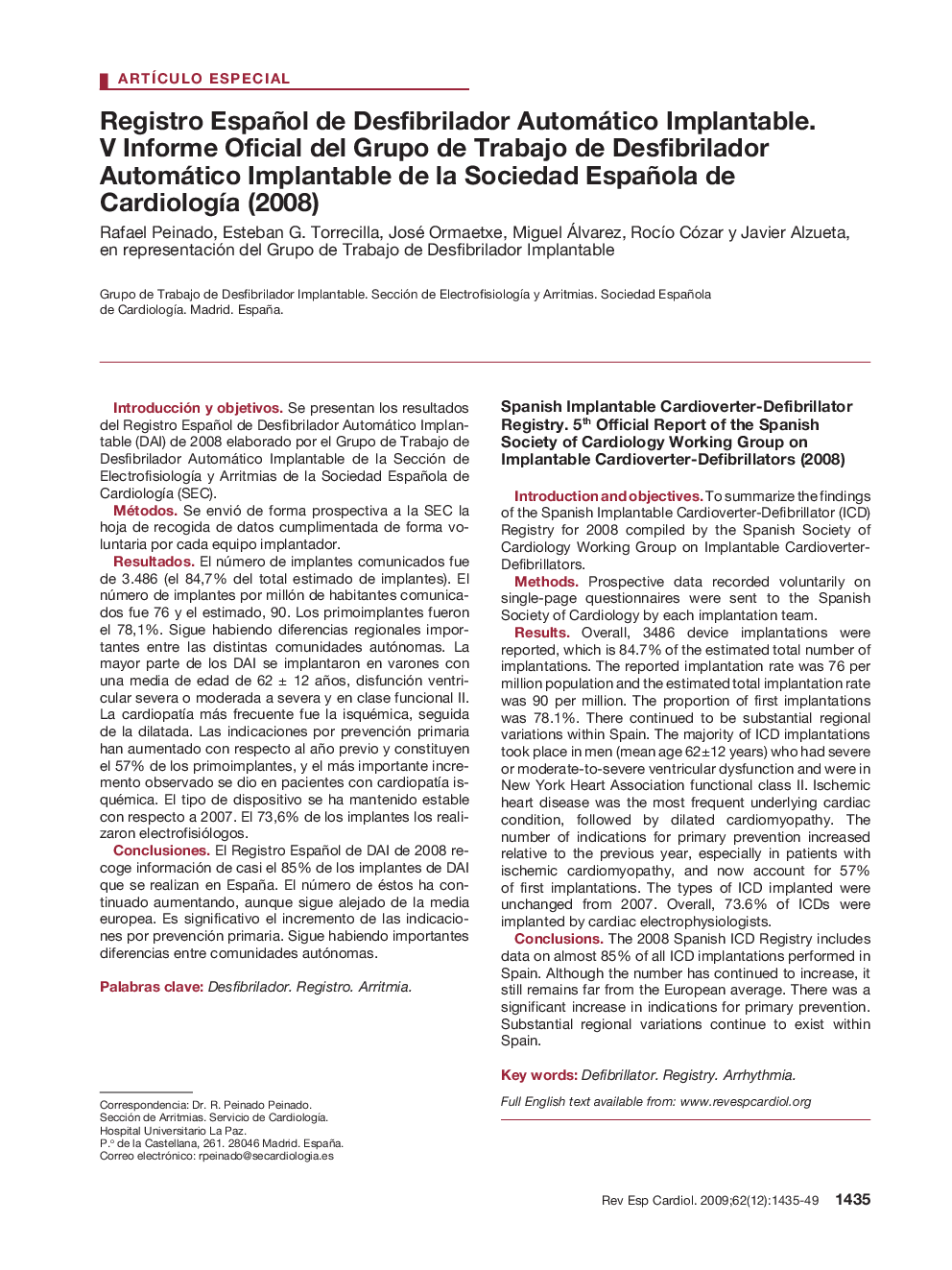| کد مقاله | کد نشریه | سال انتشار | مقاله انگلیسی | نسخه تمام متن |
|---|---|---|---|---|
| 3014346 | 1181888 | 2009 | 15 صفحه PDF | دانلود رایگان |

Introducción y objetivosSe presentan los resultados del Registro Español de Desfibrilador Automático Implantable (DAI) de 2008 elaborado por el Grupo de Trabajo de Desfibrilador Automático Implantable de la Sección de Electrofisiología y Arritmias de la Sociedad Española de Cardiología (SEC).MétodosSe envió de forma prospectiva a la SEC la hoja de recogida de datos cumplimentada de forma voluntaria por cada equipo implantador.ResultadosEl número de implantes comunicados fue de 3.486 (el 84,7% del total estimado de implantes). El número de implantes por millón de habitantes comunicados fue 76 y el estimado, 90. Los primoimplantes fueron el 78,1%. Sigue habiendo diferencias regionales importantes entre las distintas comunidades autónomas. La mayor parte de los DAI se implantaron en varones con una media de edad de 62 ± 12 años, disfunción ventricular severa o moderada a severa y en clase funcional II. La cardiopatía más frecuente fue la isquémica, seguida de la dilatada. Las indicaciones por prevención primaria han aumentado con respecto al año previo y constituyen el 57% de los primoimplantes, y el más importante incremento observado se dio en pacientes con cardiopatía isquémica. El tipo de dispositivo se ha mantenido estable con respecto a 2007. El 73,6% de los implantes los realizaron electrofisiólogos.ConclusionesEl Registro Español de DAI de 2008 recoge información de casi el 85% de los implantes de DAI que se realizan en España. El número de éstos ha continuado aumentando, aunque sigue alejado de la media europea. Es significativo el incremento de las indicaciones por prevención primaria. Sigue habiendo importantes diferencias entre comunidades autónomas.
Introduction and objectivesTo summarize the findings of the Spanish Implantable Cardioverter-Defibrillator (ICD) Registry for 2008 compiled by the Spanish Society of Cardiology Working Group on Implantable Cardioverter-Defibrillators.MethodsProspective data recorded voluntarily on single-page questionnaires were sent to the Spanish Society of Cardiology by each implantation team.Results. Overall, 3486 device implantations were reported, which is 84.7% of the estimated total number of implantations. The reported implantation rate was 76 per million population and the estimated total implantation rate was 90 per million. The proportion of first implantations was 78.1%. There continued to be substantial regional variations within Spain. The majority of ICD implantations took place in men (mean age 62±12 years) who had severe or moderate-to-severe ventricular dysfunction and were in New York Heart Association functional class II. Ischemic heart disease was the most frequent underlying cardiac condition, followed by dilated cardiomyopathy. The number of indications for primary prevention increased relative to the previous year, especially in patients with ischemic cardiomyopathy, and now account for 57% of first implantations. The types of ICD implanted were unchanged from 2007. Overall, 73.6% of ICDs were implanted by cardiac electrophysiologists.ConclusionsThe 2008 Spanish ICD Registry includes data on almost 85% of all ICD implantations performed in Spain. Although the number has continued to increase, it still remains far from the European average. There was a significant increase in indications for primary prevention. Substantial regional variations continue to exist within Spain.
Journal: Revista Española de Cardiología - Volume 62, Issue 12, December 2009, Pages 1435–1449